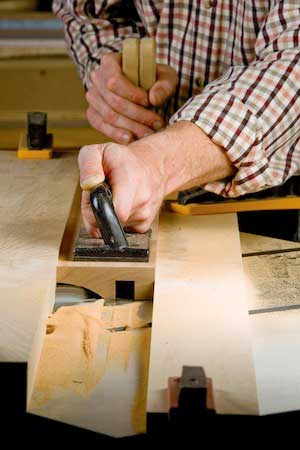
I want to build coved, raised panel doors, but I do not have the equipment. I have seen several articles on the Internet where the table saw blade mills a cove on the panel’s edges. This entails perpendicular movement of the panel blank across the table saw blade. I see this as a safety hazard without a blade guard, but what about the blade itself? Is it safe to use a table saw blade in this application, and can damage occur to the blade? – Don Horton
Tim Inman: This is a procedure for very highly skilled, very highly accomplished and experienced woodworkers. It can be done safely, but it is also a dangerous operation if not done correctly. Passing wood at an angle more or less “perpendicular” to the saw blade can indeed cut coves. The cut is NOT done all at once. Rather, the cove is cut by making multiple, progressively deeper passes. The exact angle determines the parabolic arch of the cove. A circular cove would indeed be passed at 90 degrees. An elliptical cove (more common) would be passed at some other angle. This operation requires shop-made auxiliary fences.
I do not recommend you attempt to make your panel door edges with this technique. If you have a number of panels to make, consider purchasing the correct tooling, or finding a friend that can help you. If you have only one or two, why not carve the coves? This isn’t as difficult as you might imagine. A very sharp carving chisel or two, and some time, and you’ll have your coved panels – and all your fingers left!
Chris Marshall: Don, as Tim points out, cutting coves on a table saw is definitely doable. Dialing in the correct angle of approach on the blade is what establishes the precise curvature of the cove, and that takes some mathematics or trial-and-error to get right. It’s actually a pretty cool technique, and one I used to create a large picture frame in our December 2009 print issue. Take Tim’s advice to heart: this is a technique that requires very shallow passes and a sturdy fence setup to execute safely, but it definitely can be done. Find a woodworking book that covers the setup process step by step, and follow it. Use a full-kerf blade for maximum stiffness. You won’t bend the blade or turn your workpiece into a missile if you keep each pass limited to about 1/16 inch of material removal (or less) at a pass. Certainly, this is one of those techniques that doesn’t lend itself to most typical guard styles. Use push pads and push sticks to keep your hands safely clear of the blade. Keep the wood pressed firmly down against the table at all times.







